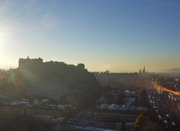Lens flare
|
|
Lens_Flare.jpg
Lens flare is a phenomenon that may occur in images or views through optical systems when they are pointed at bright sources of light. It is caused by the scattering and internal reflection and refraction of bright light in the optical components of complex lens systems, for example, those used by a camera.
It typically manifests as several starbursts, rings, or spheres arrayed in a sequence across the image or view. Typically this will become prominent when pointing a device such as a camera too near a bright source of light. Lens flare patterns will angle across the scene and change location with the camera's movement, tracking with the light position and fading as the camera points away from the bright light until it causes no flare at all.
When a bright light source is shining on the lens but not in its field of view, lens flare tends to be a bright haze that washes out the image and reduces contrast. This can often be avoided by shading the lens, either with a lens shade (lens hood) that attaches to the lens or by holding an object or hand between the light source and the lens. In a studio, a gobo can be attached to the lighting to keep it from shining on the camera.
Artificial lens flare is a common effect in various graphics editing programs, although in the graphic design community it is almost universally condemned.
External links
- Lens Flare (http://www.cambridgeincolour.com/tutorials/lens-flare.html) - Understanding flare and techniques to reduce it.ja:レンズフレア

